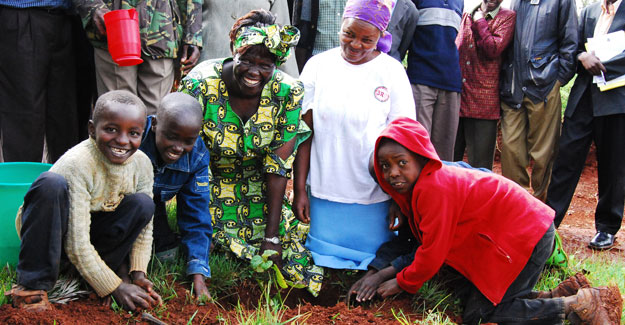“Until you dig a hole, you plant a tree, you water it and make it survive, you haven’t done a thing. You are just talking.” – Wangari Maathai
Are there projects in your community that mimic the great work of Wangari Maathai? What services do trees provide for your community, your school and your region, and how can we care for our urban forests better? These are the questions that Wangari Maathai’s story raises.
The SEMIS Coalition will be featuring a book a month to spur conversations in your classroom about this year’s themes of understanding the Commons through the lens of history and literature. The story “Wangari’s trees of peace. A true story from Africa”, by J. Winter tells one such story of the enclosure of the commons, and one woman’s response to it. According to the book, EcoJustice Education, “the ‘commons’ is a concept that allows us to recognize both the interactions between cultural and ecological systems, and the ways that certain practices, beliefs and relationships are oriented toward the future security of both” (Martusewicz, Edmundson, Lupinacci, 2011, p. 211). In this story, the globalized practice of deforestation is destroying the ecosystem surrounding Mt. Kenya, and one woman, Wangari Maathai, is working to educate and prevent the destruction of this resource while sustaining the community in the process.
As a young girl growing up in Kenya, Wangari was surrounded by trees, but years later when she returns home after studying abroad for a few years, she is shocked to see whole forests being cut down, and she knows that soon all the trees will be destroyed. So Wangari decides to do something—and starts by planting nine seedlings in her own backyard, with the help of other local women who she provides a stipend to care for the trees over three years. As they grow, so do her plans, and the Green Belt Movement is born. This true story of Wangari Maathai, environmentalist and winner of the Nobel Peace Prize, is a shining example of how one woman’s passion, vision, and determination inspired great change. Interest level is 3-5 Grades and the genre is biography and environmental science. The whole purpose of EcoJustice Education, replacing and replenishing whatever we take from nature, where trees and the forest system can be sustained through careful stewardship.
Reflect on how direct actions in place can have a more powerful effect on student learning than classroom lessons alone. From an EcoJustice perspective, we need to consider how aspects of cooperative, project-based learning in community creates teachable moments from the direct experience and understanding of local environments. Community based action enhances and supports the textbook understanding of ecology, environment and social issues by making them relevant in the local context.
* Thank you to Linda Williams and past SEMIS graduate students for their help in creating this blog post.

Wangari plants trees with youth through the Green Belt Movement.
